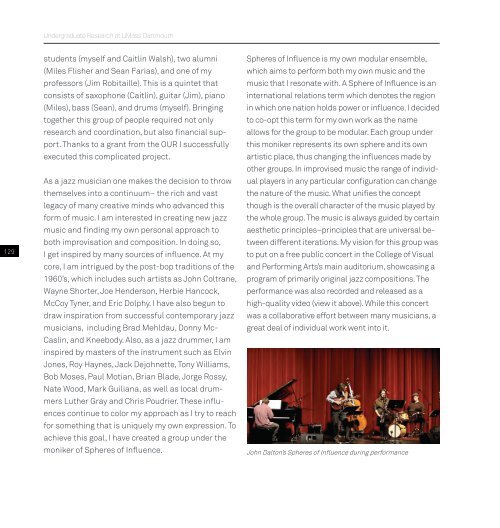Undergrad_Book_16-18_Pge_View_Print_no print marks_compressed
You also want an ePaper? Increase the reach of your titles
YUMPU automatically turns print PDFs into web optimized ePapers that Google loves.
<strong>Undergrad</strong>uate Research at UMass Dartmouth<br />
129<br />
students (myself and Caitlin Walsh), two alumni<br />
(Miles Flisher and Sean Farias), and one of my<br />
professors (Jim Robitaille). This is a quintet that<br />
consists of saxophone (Caitlin), guitar (Jim), pia<strong>no</strong><br />
(Miles), bass (Sean), and drums (myself). Bringing<br />
together this group of people required <strong>no</strong>t only<br />
research and coordination, but also financial support.<br />
Thanks to a grant from the OUR I successfully<br />
executed this complicated project.<br />
As a jazz musician one makes the decision to throw<br />
themselves into a continuum– the rich and vast<br />
legacy of many creative minds who advanced this<br />
form of music. I am interested in creating new jazz<br />
music and finding my own personal approach to<br />
both improvisation and composition. In doing so,<br />
I get inspired by many sources of influence. At my<br />
core, I am intrigued by the post-bop traditions of the<br />
1960’s, which includes such artists as John Coltrane,<br />
Wayne Shorter, Joe Henderson, Herbie Hancock,<br />
McCoy Tyner, and Eric Dolphy. I have also begun to<br />
draw inspiration from successful contemporary jazz<br />
musicians, including Brad Mehldau, Donny Mc-<br />
Caslin, and Kneebody. Also, as a jazz drummer, I am<br />
inspired by masters of the instrument such as Elvin<br />
Jones, Roy Haynes, Jack Dejohnette, Tony Williams,<br />
Bob Moses, Paul Motian, Brian Blade, Jorge Rossy,<br />
Nate Wood, Mark Guiliana, as well as local drummers<br />
Luther Gray and Chris Poudrier. These influences<br />
continue to color my approach as I try to reach<br />
for something that is uniquely my own expression. To<br />
achieve this goal, I have created a group under the<br />
moniker of Spheres of Influence.<br />
Spheres of Influence is my own modular ensemble,<br />
which aims to perform both my own music and the<br />
music that I resonate with. A Sphere of Influence is an<br />
international relations term which de<strong>no</strong>tes the region<br />
in which one nation holds power or influence. I decided<br />
to co-opt this term for my own work as the name<br />
allows for the group to be modular. Each group under<br />
this moniker represents its own sphere and its own<br />
artistic place, thus changing the influences made by<br />
other groups. In improvised music the range of individual<br />
players in any particular configuration can change<br />
the nature of the music. What unifies the concept<br />
though is the overall character of the music played by<br />
the whole group. The music is always guided by certain<br />
aesthetic principles–principles that are universal between<br />
different iterations. My vision for this group was<br />
to put on a free public concert in the College of Visual<br />
and Performing Arts’s main auditorium, showcasing a<br />
program of primarily original jazz compositions. The<br />
performance was also recorded and released as a<br />
high-quality video (view it above). While this concert<br />
was a collaborative effort between many musicians, a<br />
great deal of individual work went into it.<br />
John Dalton’s Spheres of Influence during performance



